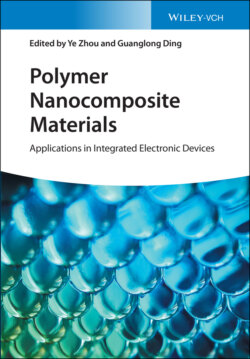Polymer Nanocomposite Materials

Реклама. ООО «ЛитРес», ИНН: 7719571260.
Оглавление
Группа авторов. Polymer Nanocomposite Materials
Table of Contents
List of Tables
List of Illustrations
Guide
Pages
Polymer Nanocomposite Materials. Applications in Integrated Electronic Devices
Preface
1. Introduction of Polymer Nanocomposites
1.1 Introduction
1.2 The Advantage of Nanocomposites
1.3 Classification of Nanoscale Fillers
1.3.1 One-Dimensional Nanofillers
1.3.2 Two-Dimensional Nanofillers
1.3.3 Three-Dimensional Nanofillers
1.4 The Properties of Polymer Nanocomposites
1.5 Synthesis of Polymer Nanocomposites
1.5.1 Ultrasonication-assisted Solution Mixing
1.5.2 Shear Mixing
1.5.3 Three Roll Milling
1.5.4 Ball Milling
1.5.5 Double-screw Extrusion
1.5.6 In Situ Synthesis
1.6 Conclusions and Future Outlook
References
2. Fabrication of Conductive Polymer Composites and Their Applications in Sensors
2.1 Introduction
2.2 Fabrication Methods for CPCs
2.2.1 Melt Blending
2.2.2 Solution Blending
2.2.3 In Situ Polymerization
2.3 Morphologies
2.3.1 Random Dispersion of Nanofiller in the Polymer Matrix
2.3.2 Selective Distribution of Nanofillers on the Interface
2.3.2.1 Segregated Structure
2.3.2.2 Surface Coating
2.4 Application in Sensors
2.4.1 Strain Sensor
2.4.2 Piezoresistive Sensor
2.4.3 Gas Sensor
2.4.4 Temperature Sensor
2.5 Conclusion
References
3. Biodegradable Polymer Nanocomposites for Electronics
3.1 Introduction
3.2 Biodegradable Polymer Nanocomposites in Electronics. 3.2.1 Polylactide
3.2.2 PCL
3.2.3 PVA
3.2.4 PVP
3.2.5 Cellulose
3.2.6 Chitosan
3.2.7 Silk
3.3 Challenges and Prospects
List of Abbreviations
References
4. Polymer Nanocomposites for Photodetectors
4.1 Introduction
4.2 Photodetector Brief
4.2.1 Photodiode
4.2.2 Photoconductor
4.3 Photodetectors Based on Novel Semiconductors
4.4 Photodetectors Based on Polymer Nanocomposites
4.4.1 Polymer–Polymer Nanocomposite
4.4.2 Polymer–Small Molecular Organic Nanocomposite
4.4.2.1 MEH-PPV–Small Molecular Organic Nanocomposite
4.4.2.2 P3HT-Small Molecular Organic Nanocomposite
4.4.3 Polymer–Polymer–Small Molecular Organic Nanocomposite
4.4.4 Polymer–Small Molecular Organic–Small Molecular Organic Nanocomposite
4.4.5 Polymer–Inorganic Nanocrystals Nanocomposite
4.4.5.1 MEH-PPV–Inorganic Nanocrystals Nanocomposite
4.4.5.2 P3HT–Inorganic Nanocrystals Nanocomposite
4.4.6 Polymer–Small Molecular Organic–Inorganic Nanocrystals Nanocomposite
4.5 Outlook
List of Abbreviations
References
5. Polymer Nanocomposites for Pressure Sensors
5.1 Introduction
5.2 Parameters for Pressure Sensors
5.2.1 Pressure Sensitivity
5.2.2 Linear Sensing Range
5.2.3 LOD and Response Speed
5.2.4 Reliability
5.3 Working Principles and Examples of Polymer Nanocomposite Based Pressure Sensors. 5.3.1 Capacitive Pressure Sensors
5.3.2 Piezoresistive Pressure Sensors
5.3.3 Piezoelectric and Triboelectric Tactile Sensors Based on Polymer Nanocomposites
5.4 Applications of the Polymer Nanocomposite Based Pressure Sensors
5.4.1 Human Wrist Pulse Detection
5.4.2 Subtle Human Motion Detection
5.4.3 Texture Roughness Detection
5.4.4 E-skin Application
5.5 Performance of Pressure Sensors with the Polymer Nanocomposites Reported Over the Past Decade
5.6 Conclusion
References
6. The Application of Polymer Nanocomposites in Energy Storage Devices
6.1 Introduction
6.2 Electrodes
6.2.1 For Battery
6.2.1.1 Polymer–Graphene/Carbon Nanotube
6.2.1.2 Polymer Inorganic
6.2.1.3 Polymer–Organic Salt Graphene
6.2.2 For Supercapacitor
6.2.2.1 Polymer–Metal Oxide
6.2.2.2 Polymer–Graphene/Carbon Nanotube
6.2.2.3 Polymer–Metal Oxide–Graphene/Carbon Nanotubes
6.3 Electrolytes
6.3.1 For Battery
6.3.2 For Supercapacitor
6.4 Separator
6.4.1 For Battery
6.4.2 For Supercapacitors
6.5 Conclusion
References
7. Functional Polymer Nanocomposite for Triboelectric Nanogenerators
7.1 Introduction
7.2 Triboelectric Nanogenerators
7.3 Functional Polymer Nanocomposite
7.4 Self-healing Triboelectric Nanogenerators
7.5 Shape Memory Triboelectric Nanogenerators
7.6 Biodegradable Triboelectric Nanogenerators
7.7 Conclusion
References
8. Polymer Nanocomposites for Resistive Switching Memory
8.1 Introduction
8.2 Resistive Switching Memory for Polymer Nanocomposite. 8.2.1 Resistive Switching
8.2.2 Resistive Switching Memory Operating Mechanism. 8.2.2.1 Formation and Rupture of Conductive Filaments
8.2.2.2 Cations and Anions Migration
8.2.2.3 Electrons Trapping and De-tapping
8.2.2.4 Other Conduction Mechanisms
8.2.3 Fabrication Techniques
8.2.4 Polymer Nanocomposite Materials
8.3 Polymer Nanocomposite Based RSM Devices. 8.3.1 Oxide Based Polymer Nanocomposite RSM
8.3.2 Metal Based Nanoparticles for Polymer Nanocomposite RSM
8.3.3 Graphene Based Polymer Nanocomposite RSM
8.3.4 Quantum Dot Based Polymer Nanocomposite RSM
8.3.5 Polymer Based Nanocomposites for RSM
8.3.6 2D Material Based Polymer Nanocomposites RSM
8.3.7 Other Materials Used for Polymer Nanocomposite Based RSM
8.4 Concluding Remarks
Acknowledgments
References
8.A Performance Comparison According to Device Material and Structure
9. Polymer Nanocomposites for Temperature Sensing and Self-regulating Heating Devices
9.1 Introduction
9.2 Conducting Mechanism and Percolation Theory
9.3 PTC Theory
9.4 Main Factors Influencing the PTC Effect
9.4.1 Effect of Filler Size and Shape
9.4.2 Effect of Filler Dispersion and Distribution
9.4.3 Effect of Mixed Filler
9.4.4 Effect of Polymer Thermal Expansion and Crystallinity
9.4.5 Effect of Polymer Transition Temperature
9.4.6 Effect of Polymer Blend
9.5 Temperature Sensors
9.6 Self-regulating Heating Devices
9.7 Conclusions
References
10. Polymer Nanocomposites for EMI Shielding Application
10.1 Introduction
10.2 Mechanism of EMI Shielding of Polymer Composites
10.2.1 Materials for EMI Shielding
10.3 Polymer Nanocomposites for EMI Shielding Application. 10.3.1 Nanofiller Incorporated Conducting Polymer Composites
10.3.2 Polymer Blend Nanocomposites for Electromagnetic Interference (EMI) Shielding
10.3.3 Conducting Polymers for EMI Shielding Application
10.4 Characterization Techniques Used for the Electrical Studies of Polymer Composites. 10.4.1 Conductivity Studies of Polymer Composites
10.4.2 Electromagnetic Interference (EMI) Shielding Studies
10.5 Conclusion
References
Index. a
b
c
d
e
f
g
h
i
k
l
m
n
o
p
q
r
s
t
u
v
w
z
WILEY END USER LICENSE AGREEMENT
Отрывок из книги
Edited by
.....
In this chapter, the basic principles, properties, and synthesis methods of PNCs are clearly described. The composite material has unique structure and performance, and has a wide range of applications in many fields. The particle size, orientation, shape, dispersion, and volume dispersion of nanofillers affect the properties of PNCs. Most of the physical, chemical, and mechanical properties of PNCs depend on the interface interaction between the filler and the matrix. Therefore, the uniform dispersion of nanofillers is the most important consideration in the synthesis of PNCs. PNCs have recently become part of modern technology, but these areas are still in the early stage of development. With more and more scientists and engineers contributing to the understanding of PNCs, these functional materials will be applied in more and more fields.
Another kind of segregated structure can be constructed by infiltration of flexible elastomers into conductive foams. Carbon based foams (e.g. graphene and CNTs) and carbonized polymer foams are usually selected as the conductive skeleton and polydimethylsiloxane (PDMS) ink was impregnated in the foam to prepare the CPCs [98–100].
.....